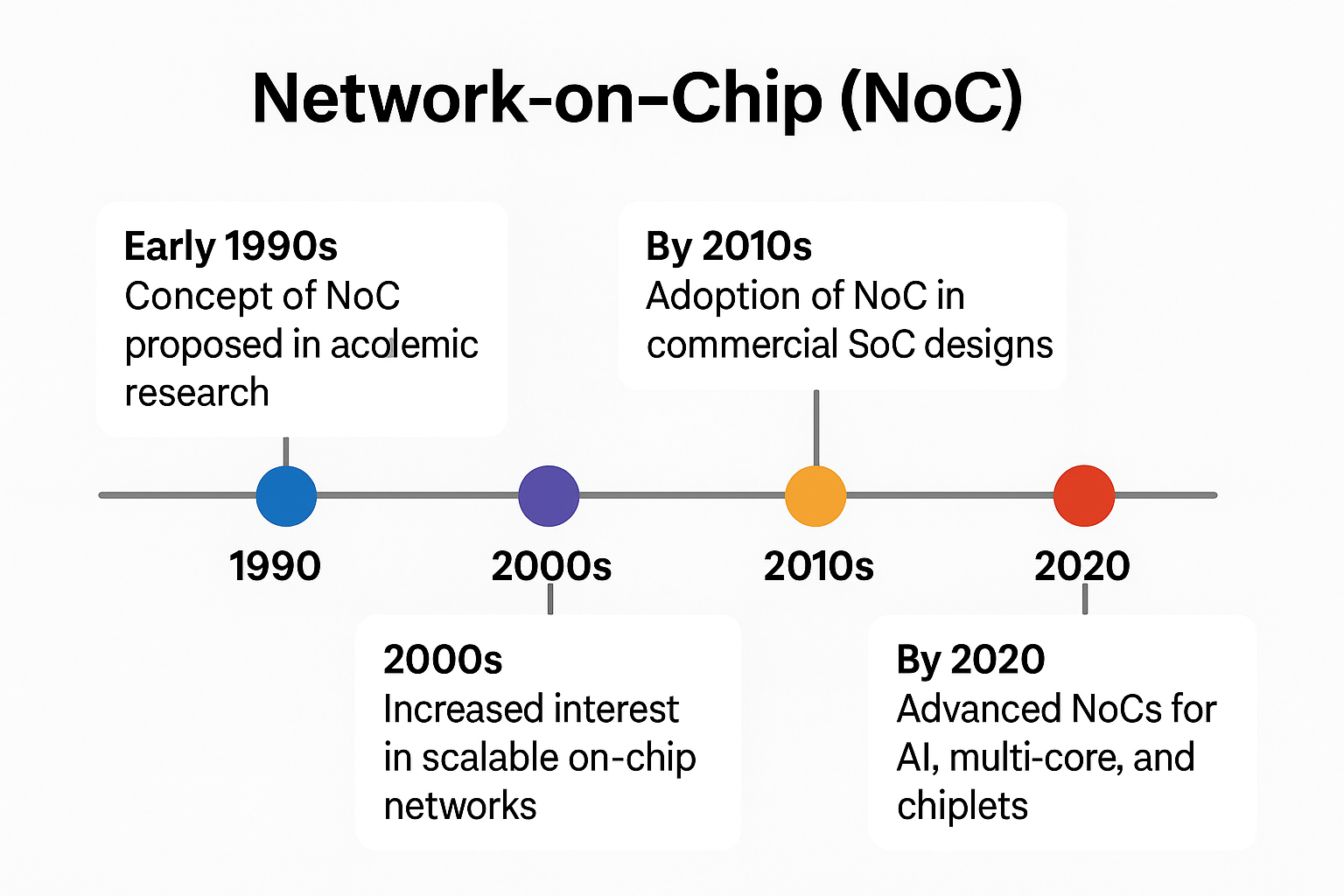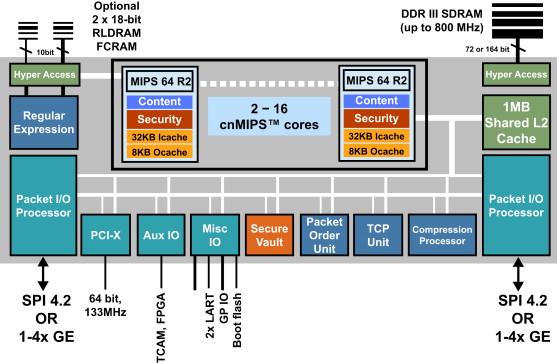
Term: Network-on-Chip (NoC)
Also Known As: On-chip Interconnect Network, SoC Interconnect Fabric
Domain: Semiconductor Architecture, System-on-Chip (SoC), Multiprocessor Design
Primary Use: Communication backbone for multi-core processors, SoCs, and chiplets
First Introduced: Early 2000s (concept); widespread in production ~2010+
Key Standards & Technologies: AMBA (Arm), CHI, TileLink, AXI NoC, proprietary fabrics
Overview
A Network-on-Chip (NoC) is a scalable communication infrastructure used to interconnect components within a System-on-Chip (SoC) or multiprocessor chip. NoCs replace traditional bus-based or point-to-point interconnects with a network-like structure composed of routers, links, and network interfaces, enabling efficient and parallel data transfers across cores, memory, accelerators, and I/O subsystems.
NoCs are critical to enabling multi-core, heterogeneous, and chiplet-based systems, where bandwidth, latency, power, and scalability are key concerns.
Why NoC?
Traditional Interconnect Challenges:
-
Shared bus bottlenecks with more cores
-
Poor scalability
-
Increased latency and congestion
-
High power and area costs for wide point-to-point links
NoC Benefits:
| Feature | Benefit |
|---|---|
| Scalability | Supports 10s to 100s of cores |
| Parallelism | Multiple simultaneous data transfers |
| Modularity | Decouples compute and communication |
| Efficiency | Optimized bandwidth, lower congestion |
| Configurability | Tailored topologies for specific workloads |
NoC Architecture Basics
1. Topology
Defines how routers and links are organized:
-
Mesh (most common in CPUs/SoCs)
-
Torus
-
Tree / Fat Tree
-
Ring
-
Crossbar
-
Hierarchical / Hybrid
2. Routing
Algorithms determine how packets move:
-
Deterministic (e.g., XY-routing)
-
Adaptive (responds to congestion)
-
Source routing (path chosen at injection)
3. Flow Control
Mechanisms to manage data traffic:
-
Wormhole routing (flit-level forwarding)
-
Virtual channels (prevent deadlock)
-
Credit-based / token-based systems
4. Switching Technique
-
Packet switching: Data in discrete packets
-
Circuit switching: Reserve path before transmission
-
Hybrid switching: Combines both
Components of a NoC
| Component | Role |
|---|---|
| Router/Switch | Directs data packets between NoC nodes |
| Link/Wire | Physical connection between routers or endpoints |
| Network Interface (NI) | Translates core/accelerator requests to network packets |
| Buffer | Temporarily stores data in routers |
| Arbiter | Resolves contention for shared resources |
Applications and Use Cases
1. Multi-core CPUs and GPUs
-
Intel, AMD, Apple, Arm, and NVIDIA chips use NoCs for connecting CPU/GPU clusters, caches, and memory controllers.
2. System-on-Chip (SoC)
-
Mobile SoCs (e.g., Qualcomm Snapdragon, Apple A-series) rely on NoCs to coordinate CPU, GPU, NPU, ISP, and DRAM.
3. AI Accelerators
-
AI chips (e.g., Google TPU, Cerebras WSE, Graphcore IPU) use advanced NoC topologies to connect hundreds or thousands of processing elements.
4. Chiplet Architectures
-
Inter-chip NoC-like fabrics (e.g., UCIe, AMD Infinity Fabric) allow chiplets to function as unified systems.
5. Heterogeneous Systems
-
Integrating CPU, GPU, DSP, NPU, and domain-specific cores with shared interconnect.
Key Commercial and Open NoC Implementations
| Provider/Type | NoC Technology |
|---|---|
| Arm | AMBA AXI, CHI Interconnect |
| Arteris IP | FlexNoC, Ncore (cache coherent) |
| NVIDIA | NVLink (chip-to-chip), mesh NoC in Grace |
| Intel | Tiled mesh NoC (Xeon), EMIB + Foveros |
| AMD | Infinity Fabric (multi-die interconnect) |
| Open-source | OpenPiton, OpenSoC, OpenNox |
| Academic | MIT RAW, Stanford SMART, Berkeley MWMR |
Design and Optimization Considerations
-
Latency vs. throughput trade-offs
-
Deadlock and livelock avoidance
-
Power-aware routing
-
QoS (Quality of Service) for real-time cores
-
Thermal-aware layout for dense 3D and chiplet designs
Advanced NoCs may also include:
-
Traffic monitoring and telemetry
-
Adaptive bandwidth allocation
-
Support for coherence protocols (e.g., MESIF, CHI)
Emerging NoC Technologies
| Innovation | Description |
|---|---|
| 3D NoC | Vertical interconnects in stacked dies (TSVs, hybrid bonding) |
| Photonic NoC | Uses light for communication to reduce latency and power |
| Wireless NoC | RF signaling for local wireless transfers in chip |
| Software-defined NoC | Programmable routing and QoS via firmware/hardware |
| AI-optimized NoC | Machine-learning trained traffic patterns and routing |
Challenges
-
Power consumption in high-frequency NoC routers
-
Verification complexity (deadlocks, protocol bugs)
-
Integration with legacy bus/IP interfaces
-
Latency variability in dynamic workloads
-
Debug and observability of internal traffic
NoC vs. Traditional Interconnect
| Feature | Traditional Bus | Point-to-Point | Network-on-Chip |
|---|---|---|---|
| Scalability | Poor | Moderate | Excellent |
| Latency | Low (small systems) | Moderate | Configurable |
| Bandwidth | Limited | Medium | High |
| Complexity | Simple | Medium | Complex |
| Flexibility | Low | Moderate | High |
Conclusion
Network-on-Chip (NoC) is a foundational technology for modern semiconductor design, enabling scalable, high-bandwidth, and efficient communication in increasingly complex chips. As SoCs grow more heterogeneous, and chiplet-based designs become standard, NoCs will evolve to support programmability, AI acceleration, and security, becoming the “nervous system” of next-generation compute platforms.
Share this post via:














Quantum Computing Technologies and Challenges